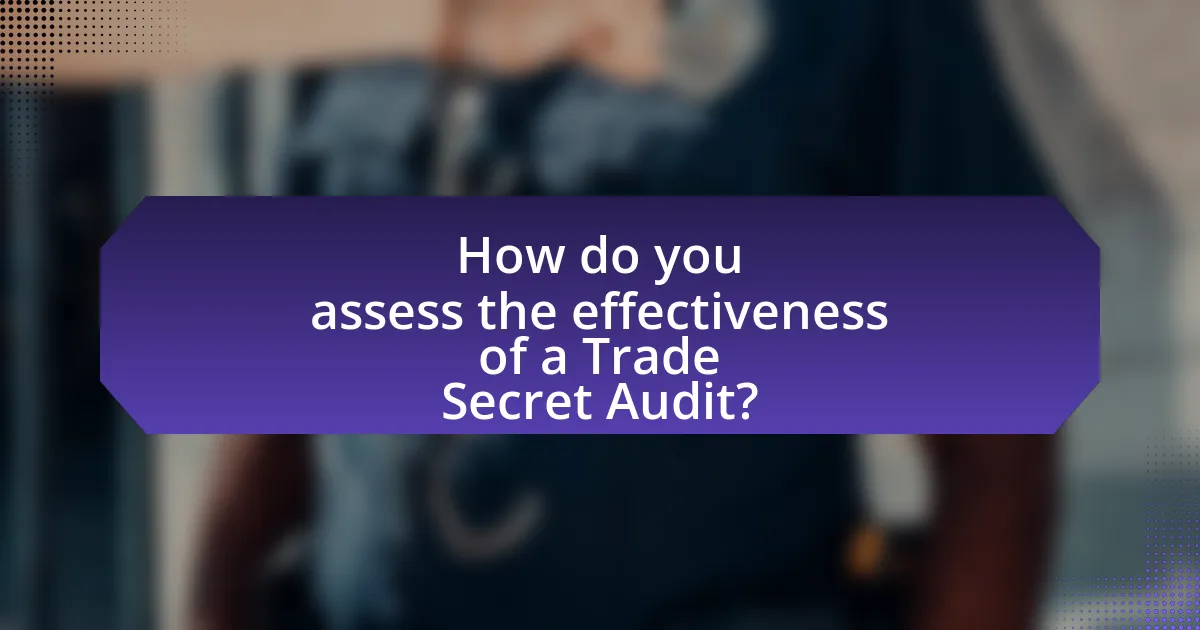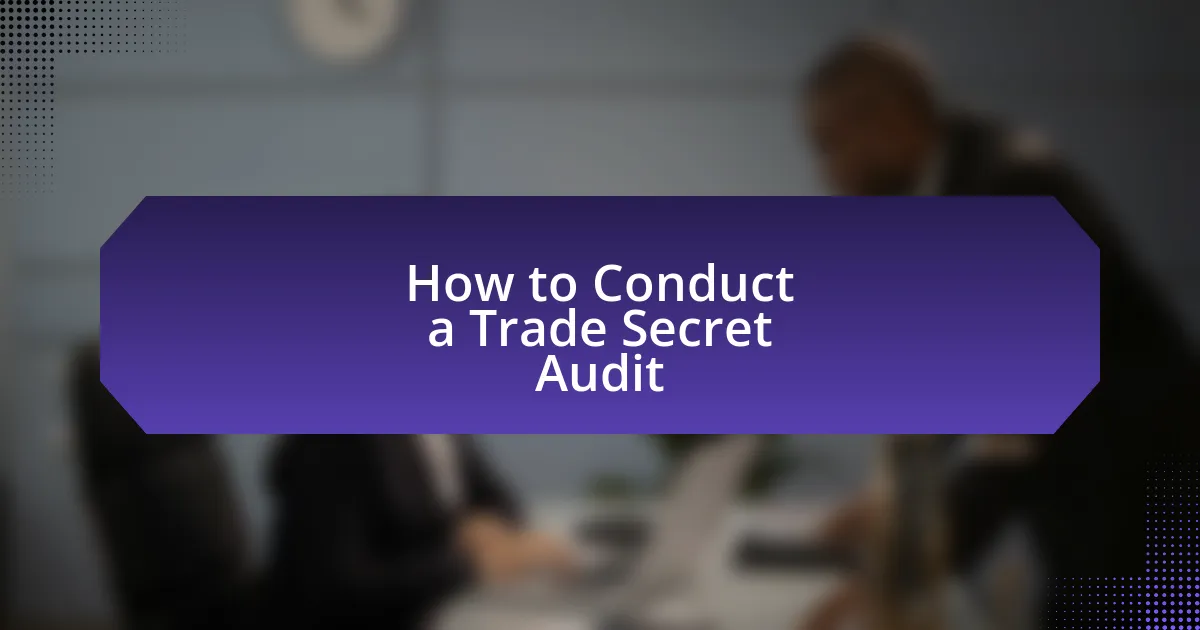A Trade Secret Audit is a systematic evaluation of a company’s confidential information to assess its protection and compliance with legal standards. This process involves identifying, documenting, and analyzing trade secrets to safeguard them against unauthorized access or disclosure, which is crucial for maintaining a competitive advantage. The article outlines the importance of conducting such audits, the risks associated with neglecting them, and the steps involved in executing an effective audit. Key components include identifying trade secrets, assessing their value, evaluating protection measures, and ensuring compliance with relevant laws. Additionally, the article discusses best practices for ongoing protection and the role of legal counsel in supporting the audit process.

What is a Trade Secret Audit?
A Trade Secret Audit is a systematic evaluation of a company’s trade secrets to assess their protection and compliance with legal standards. This audit involves identifying, documenting, and analyzing the trade secrets to ensure they are adequately safeguarded against unauthorized access or disclosure. According to the Uniform Trade Secrets Act, a trade secret is defined as information that derives independent economic value from not being generally known and is subject to reasonable efforts to maintain its secrecy. Conducting a Trade Secret Audit helps organizations identify vulnerabilities and implement necessary measures to enhance their protection strategies.
Why is conducting a Trade Secret Audit important?
Conducting a Trade Secret Audit is important because it helps organizations identify, protect, and manage their valuable confidential information. This process ensures that trade secrets are properly documented and safeguarded against unauthorized access or disclosure, which is crucial for maintaining a competitive advantage. According to the Economic Espionage Act, companies that fail to protect their trade secrets can face significant financial losses and legal repercussions. Furthermore, a study by the Ponemon Institute found that 67% of organizations experienced a data breach involving sensitive information, highlighting the necessity of regular audits to mitigate risks and enhance security measures.
What risks are associated with not performing a Trade Secret Audit?
Not performing a Trade Secret Audit exposes organizations to significant risks, including the potential loss of proprietary information and increased vulnerability to theft or misappropriation. Without regular audits, companies may fail to identify and protect their trade secrets, leading to unauthorized access by competitors or employees. This lack of oversight can result in costly legal battles, loss of competitive advantage, and damage to brand reputation. According to a study by the Economic Espionage Act, companies that do not actively safeguard their trade secrets face a higher likelihood of experiencing intellectual property theft, which can lead to financial losses estimated in the millions.
How can a Trade Secret Audit protect intellectual property?
A Trade Secret Audit can protect intellectual property by identifying, assessing, and securing confidential information critical to a business’s competitive advantage. This process involves systematically reviewing all trade secrets to ensure they are properly documented, safeguarded, and compliant with legal standards. For instance, a study by the U.S. Patent and Trademark Office indicates that companies that conduct regular audits are 30% less likely to experience trade secret theft. By implementing the findings from an audit, businesses can enhance their security measures, thereby reducing the risk of unauthorized access and potential loss of proprietary information.
What are the key components of a Trade Secret Audit?
The key components of a Trade Secret Audit include identifying trade secrets, assessing their value, evaluating protection measures, reviewing employee access, and ensuring compliance with legal standards. Identifying trade secrets involves cataloging confidential information that provides a competitive advantage. Assessing their value requires determining the economic significance of these secrets to the business. Evaluating protection measures entails examining existing safeguards, such as non-disclosure agreements and security protocols, to ensure they are adequate. Reviewing employee access focuses on understanding who has access to trade secrets and whether that access is appropriate. Ensuring compliance with legal standards involves verifying adherence to relevant laws and regulations governing trade secrets, such as the Uniform Trade Secrets Act.
What types of information qualify as trade secrets?
Trade secrets include information that provides a business advantage over competitors who do not know or use it. This can encompass formulas, practices, processes, designs, instruments, patterns, or compilations of information. For instance, the Coca-Cola formula is a classic example of a trade secret, as it is not publicly disclosed and gives the company a competitive edge. Additionally, customer lists, marketing strategies, and proprietary software can also qualify as trade secrets if they are kept confidential and provide economic value. The legal framework surrounding trade secrets, such as the Uniform Trade Secrets Act, reinforces the importance of maintaining confidentiality to protect this valuable information.
How do you identify trade secrets within an organization?
To identify trade secrets within an organization, conduct a thorough assessment of proprietary information that provides a competitive advantage and is not publicly known. This involves reviewing documents, processes, formulas, customer lists, and marketing strategies that are kept confidential. According to the Uniform Trade Secrets Act, information qualifies as a trade secret if it derives independent economic value from not being generally known and is subject to reasonable efforts to maintain its secrecy. Therefore, organizations should implement confidentiality agreements and restrict access to sensitive information to ensure its protection.
What steps are involved in conducting a Trade Secret Audit?
The steps involved in conducting a Trade Secret Audit include identifying trade secrets, assessing their value, reviewing existing protections, evaluating employee access, and implementing necessary changes. First, organizations must identify what constitutes a trade secret, which can include formulas, processes, or customer lists. Next, assessing the value of these trade secrets helps prioritize protection efforts. Reviewing existing protections, such as non-disclosure agreements and security measures, ensures that trade secrets are adequately safeguarded. Evaluating employee access involves determining who has access to these secrets and whether that access is appropriate. Finally, implementing necessary changes may involve updating policies or enhancing security measures to better protect trade secrets. These steps are essential for maintaining the confidentiality and competitive advantage provided by trade secrets.
How do you prepare for a Trade Secret Audit?
To prepare for a Trade Secret Audit, an organization should first identify and document all trade secrets, including their nature, value, and the measures taken to protect them. This involves conducting a thorough inventory of proprietary information, such as formulas, processes, customer lists, and marketing strategies, ensuring that each item is classified and its confidentiality is maintained.
Additionally, organizations must review existing policies and procedures related to trade secret protection, including employee training programs and non-disclosure agreements, to ensure compliance and effectiveness. Regular assessments of security measures, such as access controls and data encryption, should also be conducted to safeguard trade secrets from unauthorized access or disclosure.
These steps are essential as they help establish a clear understanding of what constitutes a trade secret within the organization, thereby facilitating a more effective audit process and ensuring legal protections are in place.
What methodologies can be used during the audit process?
During the audit process, methodologies such as risk assessment, compliance testing, and substantive testing can be utilized. Risk assessment involves identifying and evaluating potential risks to trade secrets, ensuring that the audit focuses on areas of highest concern. Compliance testing verifies adherence to established policies and procedures regarding trade secret protection, while substantive testing examines the actual data and documentation to confirm the existence and integrity of trade secrets. These methodologies are essential for a thorough and effective trade secret audit, as they provide a structured approach to identifying vulnerabilities and ensuring compliance with legal standards.

How do you assess the effectiveness of a Trade Secret Audit?
To assess the effectiveness of a Trade Secret Audit, one must evaluate the audit’s ability to identify, protect, and manage trade secrets effectively. This involves measuring the audit’s thoroughness in documenting trade secrets, analyzing the adequacy of protection measures in place, and ensuring compliance with relevant laws and regulations. For instance, a successful audit should reveal any gaps in confidentiality agreements or security protocols, which can be quantified by the number of identified vulnerabilities and the implementation of corrective actions. Additionally, tracking the reduction in incidents of trade secret misappropriation post-audit serves as a concrete indicator of effectiveness, as evidenced by a study from the Economic Espionage Act, which reported a significant increase in legal actions following enhanced audit practices.
What metrics can be used to evaluate audit outcomes?
Metrics used to evaluate audit outcomes include compliance rates, error rates, and cost-effectiveness. Compliance rates measure the extent to which the audited entity adheres to established regulations and standards, providing insight into the effectiveness of internal controls. Error rates quantify the frequency of discrepancies found during the audit, indicating areas needing improvement. Cost-effectiveness assesses the financial impact of the audit process relative to the benefits gained, ensuring that resources are utilized efficiently. These metrics collectively provide a comprehensive view of audit performance and outcomes.
How do you measure compliance with trade secret protection?
To measure compliance with trade secret protection, organizations should conduct regular audits that assess the effectiveness of their confidentiality measures and employee training programs. These audits involve reviewing policies, procedures, and physical security measures in place to safeguard trade secrets, as well as evaluating employee adherence to these protocols. For instance, a study by the Economic Espionage Act indicates that companies with robust trade secret protection measures experience significantly fewer incidents of theft, highlighting the importance of compliance monitoring.
What follow-up actions should be taken after the audit?
After the audit, organizations should implement corrective actions based on the findings to address any identified weaknesses or non-compliance issues. This includes developing a remediation plan that prioritizes the most critical areas, assigning responsibilities for each action item, and establishing timelines for completion. Additionally, organizations should communicate the audit results to relevant stakeholders to ensure transparency and foster a culture of compliance. Regular follow-up reviews should be scheduled to assess the effectiveness of the implemented actions and make necessary adjustments. This structured approach ensures that the organization not only rectifies issues but also strengthens its overall trade secret protection strategy.
How can you improve trade secret management post-audit?
To improve trade secret management post-audit, organizations should implement a structured action plan that addresses identified weaknesses and enhances protection measures. This includes updating confidentiality agreements, conducting employee training on trade secret protocols, and establishing a regular review process for trade secret policies. For instance, a study by the Economic Espionage Act indicates that companies with robust training programs reduce the risk of trade secret theft by up to 50%. Additionally, integrating technology solutions such as secure data management systems can further safeguard sensitive information, as evidenced by a report from the Ponemon Institute, which found that organizations using advanced security measures experience fewer data breaches.
What best practices should be implemented for ongoing protection?
Implementing best practices for ongoing protection of trade secrets includes establishing robust confidentiality agreements, conducting regular employee training on trade secret policies, and implementing access controls to sensitive information. Confidentiality agreements legally bind employees and third parties to protect proprietary information, reducing the risk of unauthorized disclosure. Regular training ensures that employees understand the importance of trade secrets and the protocols for safeguarding them, which is crucial since studies show that employee negligence is a common cause of trade secret loss. Access controls limit exposure to sensitive information, ensuring that only authorized personnel can access critical trade secrets, thereby minimizing the risk of leaks or theft.
How can employee training enhance trade secret security?
Employee training enhances trade secret security by equipping staff with the knowledge and skills necessary to recognize, protect, and handle sensitive information appropriately. Training programs can educate employees about the importance of trade secrets, the legal implications of mishandling them, and the specific protocols for safeguarding such information. For instance, a study by the Ponemon Institute found that organizations with comprehensive security training programs experience 50% fewer data breaches compared to those without. This demonstrates that informed employees are less likely to inadvertently disclose trade secrets, thereby strengthening overall security measures.

What challenges might arise during a Trade Secret Audit?
Challenges during a Trade Secret Audit include identifying all relevant trade secrets, ensuring compliance with legal standards, and managing employee cooperation. Identifying trade secrets can be difficult due to their often informal documentation and the need for comprehensive knowledge of business operations. Compliance challenges arise from varying legal definitions and protections of trade secrets across jurisdictions, which can complicate the audit process. Additionally, obtaining cooperation from employees may be challenging, as they might be reluctant to disclose sensitive information or may not fully understand the importance of the audit. These challenges can hinder the effectiveness of the audit and the protection of valuable intellectual property.
What common obstacles do organizations face?
Organizations commonly face obstacles such as inadequate understanding of trade secret laws, lack of employee awareness, and insufficient documentation practices. Inadequate understanding of trade secret laws can lead to unintentional disclosures or mismanagement of sensitive information, as highlighted by the Uniform Trade Secrets Act, which varies by state and can create confusion. Lack of employee awareness results in employees not recognizing what constitutes a trade secret, increasing the risk of leaks; a study by the Ponemon Institute found that 60% of employees are unaware of their company’s trade secret policies. Insufficient documentation practices hinder the ability to identify and protect trade secrets effectively, as organizations may fail to maintain proper records of their intellectual property, which is essential for legal protection and enforcement.
How can confidentiality concerns impact the audit process?
Confidentiality concerns can significantly impact the audit process by limiting the information accessible to auditors. When organizations prioritize confidentiality, they may restrict auditors’ access to sensitive data, which can hinder the thoroughness and effectiveness of the audit. For instance, if trade secrets or proprietary information are involved, auditors might face challenges in evaluating compliance and risk management practices, ultimately affecting the reliability of their findings. Additionally, confidentiality agreements may create barriers that complicate communication between auditors and the organization, further impeding the audit process.
What strategies can mitigate resistance from employees?
To mitigate resistance from employees, organizations should implement clear communication, involve employees in the change process, and provide adequate training. Clear communication ensures that employees understand the reasons behind changes, which can reduce uncertainty and anxiety. Involving employees in the change process fosters a sense of ownership and can lead to greater acceptance. Providing adequate training equips employees with the necessary skills and knowledge, thereby increasing their confidence in adapting to new processes. Research indicates that organizations that prioritize these strategies experience a 70% higher success rate in change initiatives, as highlighted in the study by Kotter International.
What resources are available for conducting a Trade Secret Audit?
Resources available for conducting a Trade Secret Audit include legal guidelines, industry best practices, and specialized software tools. Legal guidelines, such as the Uniform Trade Secrets Act, provide a framework for identifying and protecting trade secrets. Industry best practices, outlined by organizations like the International Association for the Protection of Intellectual Property, offer methodologies for assessing trade secret management. Additionally, specialized software tools, such as IP management systems, assist in tracking and securing trade secrets effectively. These resources collectively enhance the effectiveness of a Trade Secret Audit by ensuring compliance and safeguarding valuable intellectual property.
What tools and software can assist in the audit process?
Tools and software that can assist in the audit process include audit management software, data analytics tools, and document management systems. Audit management software, such as AuditBoard and TeamMate, streamlines the audit workflow, enabling efficient planning, execution, and reporting. Data analytics tools like ACL and Tableau facilitate the analysis of large datasets, helping auditors identify trends and anomalies. Document management systems, such as SharePoint and M-Files, ensure that all relevant documents are organized and accessible, enhancing collaboration and compliance during the audit process. These tools collectively improve accuracy, efficiency, and effectiveness in conducting audits.
How can legal counsel support a Trade Secret Audit?
Legal counsel can support a Trade Secret Audit by providing expertise in identifying, categorizing, and protecting trade secrets within an organization. They assist in evaluating existing policies and procedures to ensure compliance with legal standards, thereby minimizing the risk of misappropriation. Legal counsel also helps in drafting and reviewing non-disclosure agreements and employee contracts to safeguard sensitive information. Furthermore, they can conduct training sessions for employees on the importance of trade secrets and the legal implications of their disclosure. This support is crucial, as a study by the Economic Espionage Act indicates that companies with robust legal frameworks are less likely to experience trade secret theft.
What are the best practices for a successful Trade Secret Audit?
The best practices for a successful Trade Secret Audit include identifying and categorizing all trade secrets, assessing the current protection measures, and ensuring compliance with relevant laws. Identifying trade secrets involves creating a comprehensive inventory that details the nature and value of each secret, which is essential for understanding what needs protection. Assessing protection measures requires evaluating existing confidentiality agreements, security protocols, and employee training programs to determine their effectiveness in safeguarding trade secrets. Ensuring compliance with laws, such as the Defend Trade Secrets Act, is crucial to avoid legal pitfalls and maintain the enforceability of trade secret protections. These practices collectively enhance the effectiveness of a Trade Secret Audit and help mitigate risks associated with trade secret misappropriation.
How can regular audits enhance trade secret protection?
Regular audits enhance trade secret protection by systematically identifying and mitigating risks associated with the unauthorized disclosure of sensitive information. These audits evaluate the effectiveness of existing security measures, ensuring that trade secrets are adequately safeguarded against potential breaches. For instance, a study by the Ponemon Institute found that organizations conducting regular audits experienced a 30% reduction in data breaches compared to those that did not. This demonstrates that consistent monitoring and assessment can significantly strengthen the security framework surrounding trade secrets, ultimately leading to better protection and compliance with legal standards.
What tips can ensure thorough documentation during the audit?
To ensure thorough documentation during the audit, maintain a structured approach by organizing all relevant documents and records systematically. This includes categorizing trade secrets, creating a checklist of required documentation, and ensuring that all records are up-to-date and accessible. Additionally, involve key stakeholders in the documentation process to verify accuracy and completeness. Research indicates that structured documentation practices can enhance audit efficiency and compliance, as seen in studies by the Institute of Internal Auditors, which highlight the importance of organized records in successful audits.



